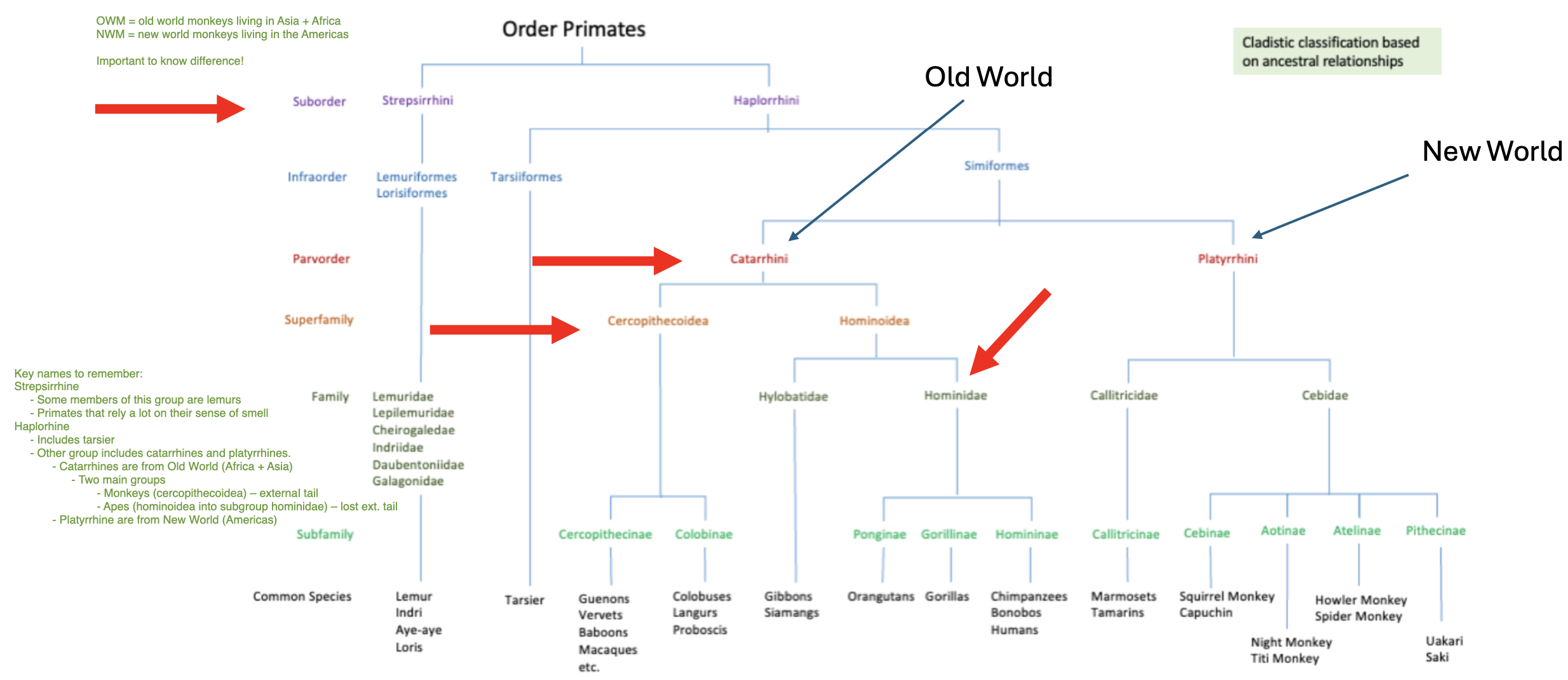Lesson 7 - Non-Human Primates & Human Evolution
1/12
There's no tags or description
Looks like no tags are added yet.
Name | Mastery | Learn | Test | Matching | Spaced |
|---|
No study sessions yet.
13 Terms
Why study primates?
• Understand human biology, social behavior, culture
• Formulate hypothesis of how our ancestors behaved
• Living primates are still evolving (Primates have all evolved, so other primates are not replica of our shared common ancestors from thousands/millions of years ago)
How are there variations in primates?
There is great variation in primates
• Heterogeneous order (~500 species)
• Body size (from 40g mouse lemur to 200 kg gorilla)
• Brain size (2g in mouse lemur to 1.2 kg humans)
Show primate taxonomy.
Important names:
Strepsirrhine
Some members of this group are lemurs
Primates that rely a lot on their sense of smell
Haplorhine
Includes tarsier
Other group includes catarrhines and platyrrhines.
Catarrhines are from Old World (Africa + Asia). Two main groups:
Monkeys (cercopithecoidea) – external tail
Apes (hominoidea into subgroup hominidae) – lost ext. tail
Platyrrhine are from New World (Americas)

What is a primate?
• Grasping hands and feet (and tail)
• Opposable thumb (and toe)
▪ Flattened nails instead of claws (except marmosets, tamarins)
▪ Fingertip pads
• Diurnal (most primates, but some nocturnal)
• Arboreal (live in trees, humans are exceptions)
• Forward-facing eyes (depth perception, important for animals that jump from trees to trees)
• Increased reliance vision and less on olfaction (Other than strepsirrhine)
• Give birth to one offspring at a time (exception: marsupials usually give birth to twins)
This is bc there is longer gestation + offspring dependency once born
• Diet: leaves, fruit, insects, some meat
• Generalized dentition (leaves, fruits, plant products, insects, small mammals)
• Large brains (relative to body size)
• Longer offspring dependency on mother
• Live in social groups (hierarchies, complex relationships)
(Not all primates have all these features, but have at least a few)
How do we study primates?
• Primatology, biological anthropology, comparative psychology
• Wild settings
• Zoos, research facilities
Primatology + Bio Anthro = mostly study in wild settings
Comp Psych = mostly study in captivity
What is researched with primates?
• Communication
• Social behavior, social structure
• Aggressive behavior
• Affiliative behavior
• Subsistence, diet, ecology
• Tool use
• Life history
• Conservation
Humans & Primates history.
Origin of all primates ca 70-80mya
Origin of old world monkeys and apes ca 30mya
Important point: Shared common ancestor of humans and chimpanzees lived ca 7mya
Ie. we are most similar to chimpanzees, and they are more similar to us than either of us are to gorillas or orangutans
What are some key points about primates?
• Independent lines of research confirm that we are primates
• Primates originated around 70-79 mya
• Humans closest living relatives are great apes of Africa
• Humans closest living relative among the great apes of Africa are chimpanzees (Pan troglodytes) and bonobos (Pan paniscus)
• Have been looking at genetic + molecular data to confirm lineages → confirms anatomical data and that we are indeed primates
What are hominins?
• Modern humans and extinct ancestors.
• It is a subtribe, the group of individuals that include us and all other hominin species that are very closely related to us after split with chimpanzees
• The reason there are lots of skulls is because we know these close species due to fossil records
• It’s a very populated lineage, a lot happened, a lot of species lived during the 7 million years, and we are the only ones that survived
Who were two important contributors who started the fossil record?
William King (geologist) 1809-1886 → Homo Neanderthalensis (1864)
Raymond Dart 1893-1988), anatomist, anthropologist → Australopithecus Africanus (Taung child, 2.8 mya)
Often the names of species come from the place they found the fossils
What is an example of a Possible Hominin?
Sahelanthropus tchadensis
• Discovered: 2001
• Where: West-central Africa (Chad) • When: 7-6 mya
• Small brain
• Prominent brow ridges
• Elongated skull
• Smaller canines
• Forward foramen magnum
• Walking upright
More sloping than our face, large canines (but smaller than other apes)
Mixed traits between what humans and apes would look like
It’s debated whether they walked upright
A specific hole in the skull (where the spine connects to the brain) can help show whether a species walk upright or not (humans it’s more centered, walk upright vs. chimpanzee it’s more in the back, means walks on all fours) – this species it’s debated whether the hole is in the center or far enough back to move more like an ape or a human
What is an example of an Archaic Hominin?
Australopithecus Afarensis (Lucy), Australopithecus Africanus
• 3.85 and 2.95 mya
• Southern, Eastern Africa
• Strong arms for climbing trees
• Ape-like face
• Smaller canines
• Small brain (400 cm3)
• Diet: grasses, seeds, roots (strong jaws)
• Adaptations for both life on ground and trees
Usually have a combination of ape-like features (long arms to live in trees, ape-like face) and human-like features (smaller canines like us)
Remember the two names on the slide (afarensis lived in east Africa, africanus lived in south Africa)
What is an example of a Megadont Archaic Hominin?
Paranthropus boisei
• Discovered: 1959
• 2.3-1.2 mya
• Lived in East Africa
• Large molars for grinding
• Large ridge at top of skull to anchor large jaw muscles
Large teeth: Prominent ridge at top of skull that controls muscles of jaw, implies they have massive muscles to control the jaw to use their teeth a lot to grind touch materials